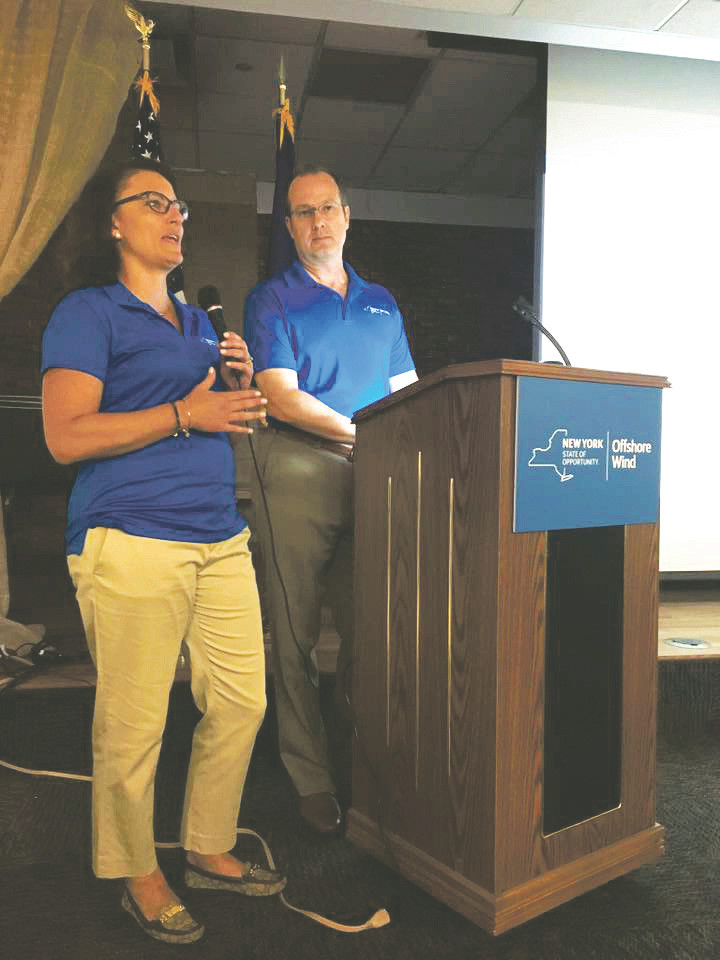State launches public hearings on site of offshore wind farm
Posted
The New York State Energy Research and Development Authority launched a series of public meetings at the Long Beach Public Library on July 11 as part of an outreach effort as the state moves forward with a plan to build wind farms off the South Shore.
The meeting engaged the public, as well as stakeholder groups such as fishermen and the maritime industry in order to generate feedback as early as possible in the planning process for wind farms that would be located 14 miles off the coast of Long Beach, according to state officials.
The efforts coincide with Gov. Andrew Cuomo’s goal to pursue options like offshore wind to produce 50 percent of the state’s electricity needs from renewable energy sources by 2030.
Cuomo announced in his 2017 State of the State address that New York aims to develop up to 2.4 gigawatts of offshore wind in 13 years off the Atlantic coast — enough to power 1.25 million homes.
Doreen Harris and Greg Matzat, of the large-scale renewables team at NYSERDA — a state agency that is leading the effort to develop offshore wind — offered information about their Offshore Wind Master Plan, which is expected to be completed and released by the end of the year.
As part of the plan, state officials said, NYSERDA is conducting more than 20 studies in a 16,740-square-mile area of the Atlantic Ocean. Only 2 percent of the study area, though, would be needed to meet the state’s goal of 2.4 gigawatts by 2030. According to Matzat, that would require 240 to 300 turbines.
The results of the studies will be available to project developers and various stakeholders, and will suggest the best possible sites for wind development and establish guidelines for developers.
“That’s really the point of the master plan — to advance offshore wind for the state in a way that is responsible and takes into account the varying uses of our ocean in our planning activities,” Harris said. There are “three major components: identify sites that are best suited for the development; create guidelines as a state; advance offshore wind to the point where it’s competitive.”
Additionally, the offshore wind industry is expected to support 160,000 jobs over the next 30 years, according to the U.S. Department of Energy, and help protect the environment by reducing harmful emissions by 5 million tons per year.
Harris and Matzat also explained that the turbines would not be visible from the shoreline. The state plans to set guidelines that developers must abide by, which will include a minimum distance from the shore that turbines can be constructed.
The fishing industry won’t be impacted, either, according to NYSERDA, because the state does not plan to impose any restrictions on fishing around the wind turbines, which will likely be about a mile apart. The aim is to allow the wind farms and the fishing industry to co-exist.
So far, wind farms off the coast of Long Island are in their early planning stages.
“To date, the [U.S. Department of the Interior’s Bureau of Ocean Energy Management] has leased six areas for offshore wind between New Jersey and Massachusetts,” Matzat said. “All these leases have been awarded to companies through competitive auctions that the BOEM has had. The leases give these companies the rights to do site assessments and propose projects for construction.”
The Long Island Power Authority recently approved a contract submitted by Deepwater Wind for operation of the South Fork Wind Farm, a 90-megawatt development 30 miles west of Montauk that is in its early planning stages, according to state officials.
“These megawatts are the first towards our 2,400-megawatt goal,” Matzat said. He added that the South Fork Wind Farm is expected to be completed in 2022 and operational in the mid-2020s.
Last week’s meeting came after another company won a lease off the Long Beach coast in February. With a bid of $42.5 million at an auction held by the federal government, a Norwegian energy company, Statoil Wind US LLC, won the lease for an area that would provide the state with about 800 megawatts of offshore wind power.
Cuomo called on NYSERDA to work with Statoil to ensure that the project delivers power “cost-effectively and responsibly.” Last year, the governor rejected plans to build a liquefied natural gas terminal about 16 nautical miles off the coast of Jones Beach because it would have conflicted with the site of potential wind farms.
“This is part of a much longer trajectory, and we in Long Beach and on the South Shore stood against the Port Ambrose liquefied natural gas terminal a year and a half ago to make room for a project just like this,” said State Sen. Todd Kaminsky.
“We’re really excited that we’re moving forward with our energy goals, that we’re being progressive in promoting renewable energy. You can count on one hand the amount of big renewable wind projects in the United States, and for us to be the home for one of them I think is tremendous.”
“It’s a very inclusive and very exhaustive process because it needs to be done right,” said George Povall, director of a local environmental group called All Our Energy. “As an environmental group, we really support that. We’d like to see it done faster, but it’s not going to happen. We want to make sure it’s done right.”
Report an inappropriate comment
Comments

 66.0°,
A Few Clouds
66.0°,
A Few Clouds 




